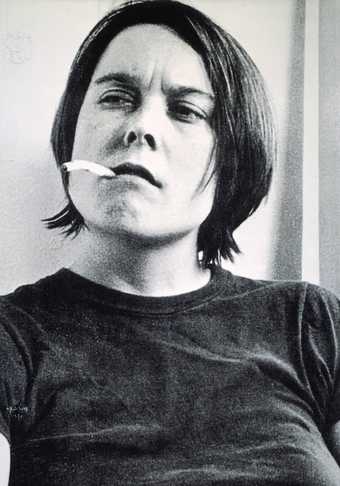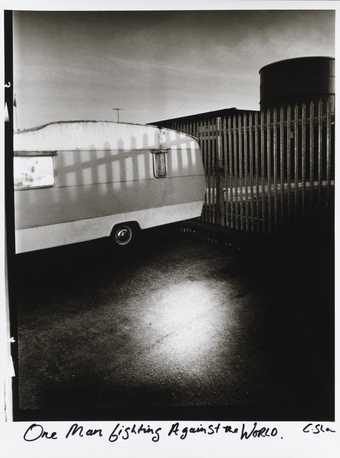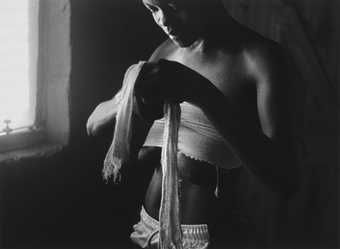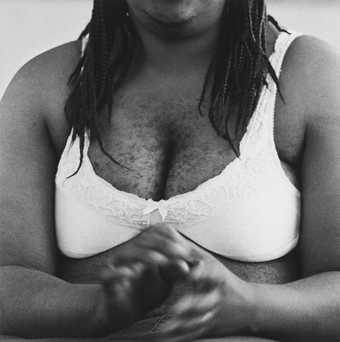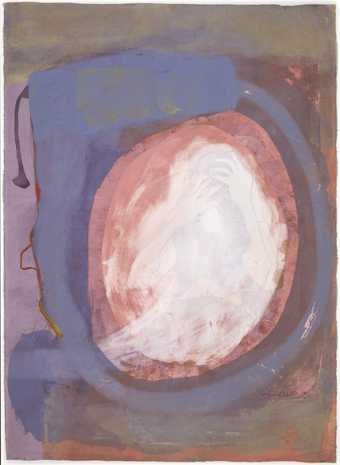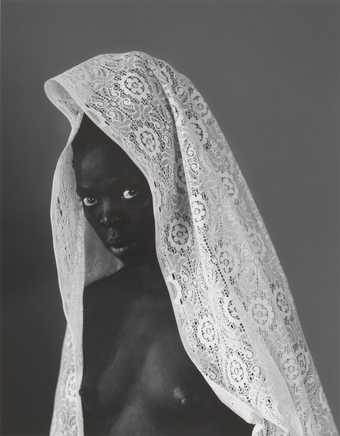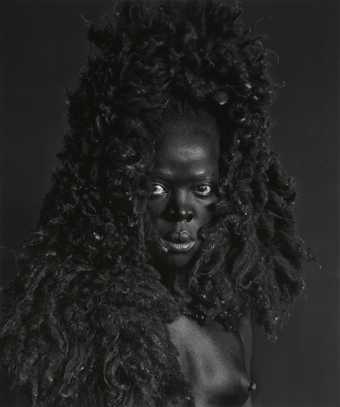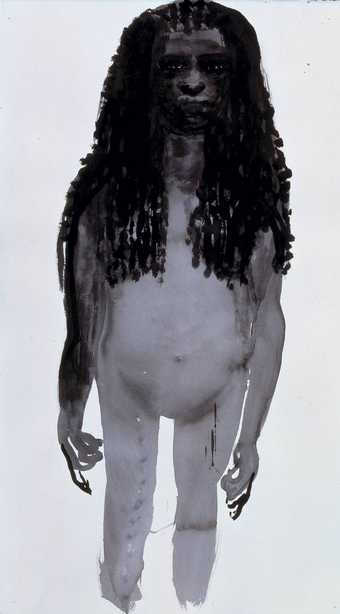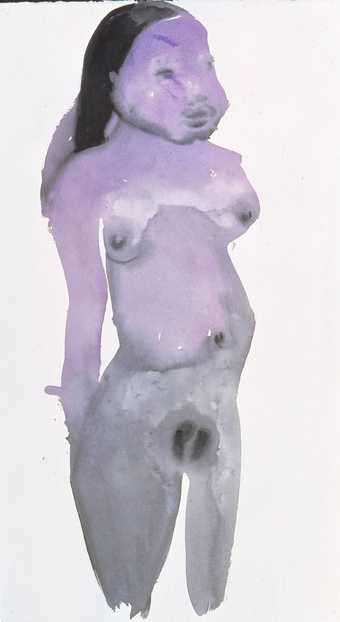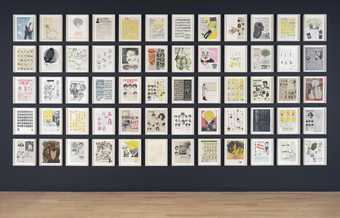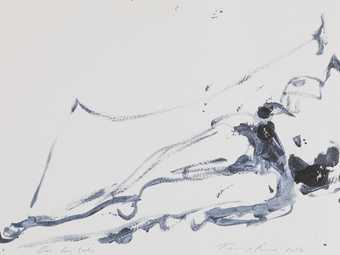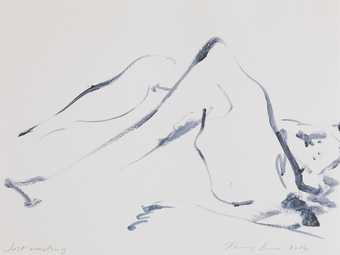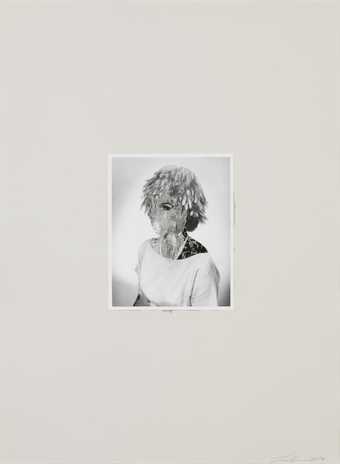
Not on display
- Artist
- Virginia Chihota born 1983
- Original title
- Kuzvirwisa
- Medium
- Screenprint on paper
- Dimensions
- Frame: 1384 × 1890 × 50 mm
unconfirmed: 1300 × 1800 mm - Collection
- Tate
- Acquisition
- Purchased with funds provided by the Guaranty Trust Bank plc 2017
- Reference
- T14806
Summary
This is one of two screenprints in Tate’s collection by Virginia Chihota that share the same title and date; where this one is landscape format, the other (Tate P81969) is portrait format. Both prints are unique and therefore not editioned, and form part of an ongoing series of monoprints – five at the time of writing – with the collective title Fighting One’s Self (‘Kuzvirwisa’ in the artist’s native Shona language). The title and images communicate varying aesthetic approaches to the theme of mental and physical isolation. Though created in series, the works are considered individual and can be displayed as such. This particular print is dominated by luminous gold ink, suspended in the centre of which is a large sac-like form positioned along its horizontal axis. The ovoid shape contains a human figure whose small black face and torso recede in relation to the flexed arm and disproportionately elongated leg, both articulated in taupe. The warm pink tones surrounding the figure are accented by two small striated Y-shapes rendered in blood red, evoking a uterine environment, and a colour prevalent in much of Chihota’s earlier work. The portrait-format print has a cool palette of predominantly blue and purple, overlaid by thin washes of red. Large concentric ovals of blue, purple and pale red form egg-like layers, within which a figure shields its face from view. The composition of both prints bears strong allusions to fertility, the placement of the human figure within such a sac being intentionally womb-like.
Chihota’s work across drawing, painting and printmaking is deeply introspective, characterised by her use of symbols referring to female anatomy and foetal positions, rich colour and graphic forms to convey her perspective on personal experiences. In Fighting One’s Self she chose the Shona term for inner turmoil to address the fraught struggle to maintain a sense of self in the midst of change, a concern that she has described as the defining element of her practice: ‘My work is a reflection on the search for one’s self (and the perenniality of the self) in changing circumstances. Displacement creates uncertainty but the imperative to survive and the continuity one manages to maintain despite changing conditions inspires me.’ (Quoted in Kinsmann 2015, accessed September 2016.)
Chihota has drawn on recent changes in her circumstances, in particular becoming a wife and mother, and a temporary relocation to Tripoli in Libya with her family in 2012, followed by a turbulent period of displacement and relocation in the face of the escalating Libyan Crisis. While her choice of title foregrounds this personal tumult, her works have become increasingly abstract. They are rich in symbolic reference to fertility, loneliness and female subjectivities associated with traditional gender roles linked to pregnancy and the sequestration that can come with tending to very young children. Where figures do appear, they are places so as to convey nuances of dislocation, isolation and loneliness. The motif of the inverted body or head – as in Receiving Life (Kugamuchira Hupenyu) 2013 and Raising Your Own (Kurera Wako) 2014 – is one example. Another is the singular female figure placed within a block of colour or pattern that is surrounded by an expanse of blank space, as in the series The Root of the Flower We Do Not Know (Mudzi Weruva Ratisingazive) 2014. When multiple figures do appear in the same image, Chihota tends to signify disconnect by depicting them turned away from one another, or segregated into different quadrants, such as in The Prince of Life (Kuna Muvambi Wehupenyu) 2013 and the series Trust and Obey (Kuvimba Nekuterera) 2013.
Such concerns are also at the heart of works such as The Constant Search for Self (Kudzokorodza Kuzvitsvaga) 2013, also in Tate’s collection (Tate T14350). Separate, bulbous forms convey a sense of female loneliness or entrapment, while the gesture of obscuring them with washes of colour or densely applied marks further suggests loss of visibility, voice and agency. Ideas of nurture and safety associated with the womb seem antithetical to these concepts of being alone, yet it is precisely because of this that it holds especial significance to Chihota’s reading and representation of the universal quest for selfhood. Reflecting on the meaning behind her symbolic use of the womb in relation to the human condition, she has said that it is ‘an all-encompassing symbol for fertility, for a woman’s gift for gestation and the creation of life, a woman’s intuition and psychic abilities, and the subconscious … No one is excluded from being fruit of the womb and all that that encompasses. It yields to the human condition.’ (Ibid.)
Further reading
Portia Zvavahera et al., Dudziro: Interrogating the Visions of Religious Beliefs, exhibition catalogue, Zimbabwe Pavilion, Venice Biennale, 1 June–24 November 2013.
Houghton Kinsmann, ‘Depicting Thorns in Virginia Chihota’s Flesh’, AnotherAfrica.net, 28 January 2015, http://www.anotherafrica.net/art-culture/depicting-thorns-in-virginia-chihotas-flesh, accessed September 2016.
Emma Lewis and Zoe Whitley
June 2016
Does this text contain inaccurate information or language that you feel we should improve or change? We would like to hear from you.
Explore
- emotions, concepts and ideas(16,416)
-
- emotions and human qualities(5,345)
- formal qualities(12,454)
-
- assemblage / collage(47)
- gestural(763)
- texture(466)
- universal concepts(6,387)
-
- fertility(48)
- womb(31)
- black(796)
- lifestyle and culture(10,247)
-
- cultural identity(7,943)
You might like
-
Sarah Lucas Fighting Fire with Fire
1996 -
Chris Shaw One Man Fighting against the World
2007–12 -
Zanele Muholi ID Crisis
2003 -
Zanele Muholi Bra
2003 -
Virginia Chihota Fighting One’s Self
2016 -
Zanele Muholi Thembeka I, New York, Upstate
2015 -
Zanele Muholi Somnyama IV, Oslo
2015 -
Marlene Dumas Magdalena 1
1996 -
Marlene Dumas Magdalena 5
1996 -
Ellen Gallagher DeLuxe
2004–5 -
Tracey Emin On her Side
2014 -
Tracey Emin Just Waiting
2014 -
Virginia Chihota The Constant Search for Self
2013 -
Lorna Simpson Grew Feathers
2016


